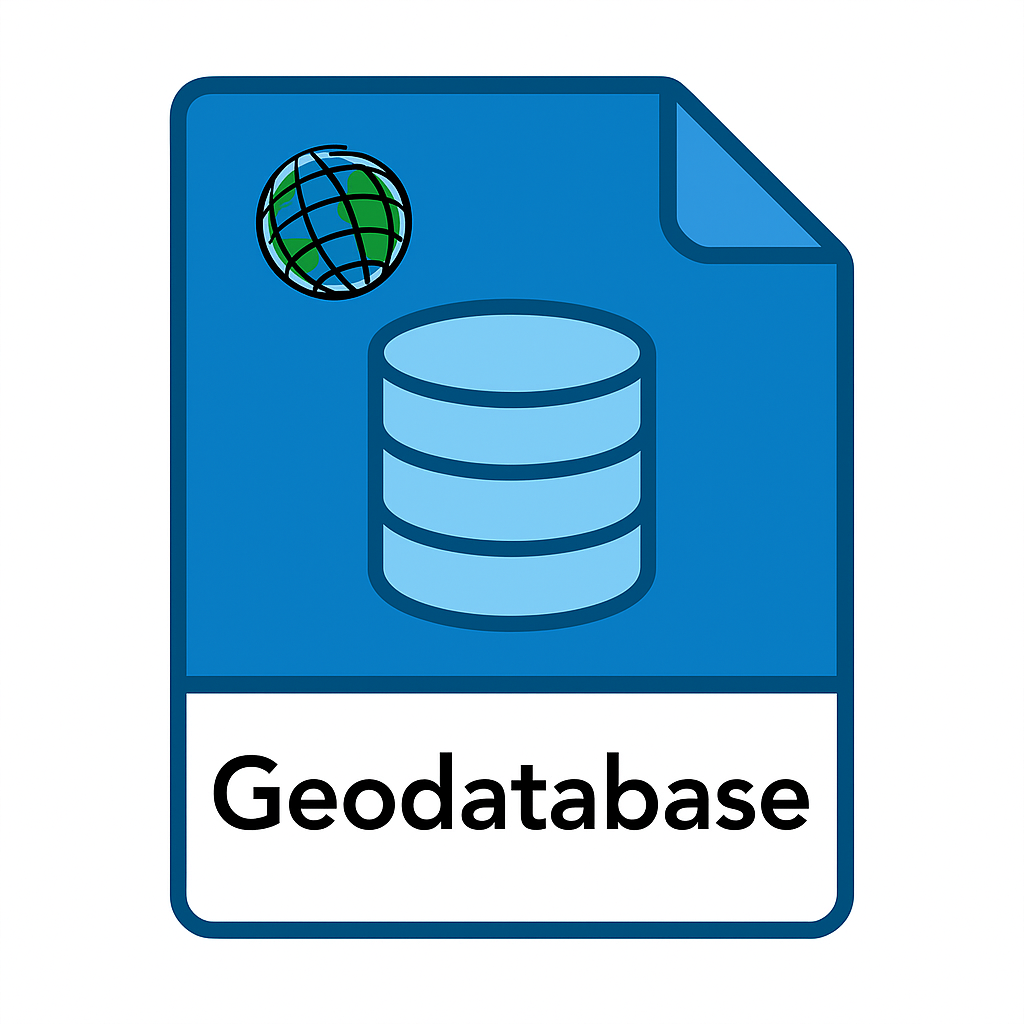Part 3: Geodatabase Data Models and Schema Design
Effective geodatabase schema design is fundamental to creating robust, efficient, and maintainable spatial data systems. The geodatabase data model provides sophisticated tools for organizing spatial and attribute data that go far beyond simple file-based storage, enabling the implementation of complex real-world relationships and business rules within the spatial database.
Fundamental Geodatabase Components
Feature Classes: The Building Blocks of Vector Data Feature classes represent collections of geographic features that share the same geometry type, attribute schema, and spatial reference system. Unlike shapefiles, which are limited to single geometry types and constrained field naming conventions, geodatabase feature classes support complex data models with descriptive field names, advanced data types, and sophisticated validation rules.
Each feature class can store millions of features while maintaining performance through automatic spatial indexing and optimized storage structures. The geodatabase supports multiple geometry types including points, multipoints, polylines, polygons, and specialized types like annotation features and dimension objects.
Feature class design should reflect both the geometric nature of the data and the business processes that will interact with it. This includes consideration of appropriate geometry types, attribute schema design, and spatial reference system selection that supports the intended analysis and visualization requirements.
Tables: Managing Non-Spatial Attribute Data Geodatabase tables store non-spatial data that may be related to spatial features through relational joins or stand-alone reference information. Tables support the same advanced field types as feature classes, including GUID fields for unique identification, date fields with time zone support, and BLOB fields for storing complex data types.
The design of table schemas should consider normalization principles to eliminate redundant data while maintaining efficient query performance. Proper indexing strategies ensure that table joins and queries perform efficiently even with large datasets.
Feature Datasets: Organizing Related Feature Classes Feature datasets provide logical grouping for related feature classes that share a common spatial reference system and may participate in advanced geodatabase functionality like topology or geometric networks. Feature datasets are essential for implementing sophisticated spatial data models that require coordination between multiple feature classes.
All feature classes within a feature dataset must share the same coordinate system, including the same spatial reference, coordinate system units, and spatial domains. This requirement ensures spatial integrity and enables advanced functionality that depends on precise spatial relationships between features.
The organization of feature classes into feature datasets should reflect logical data groupings and functional requirements. Common approaches include organizing by theme (e.g., transportation, utilities, land records), by scale (e.g., regional, local, detailed), or by administrative responsibility.
Advanced Data Modeling with Relationship Classes
Defining Data Relationships Relationship classes provide explicit definition and management of relationships between tables and feature classes within the geodatabase. Unlike simple table joins, relationship classes maintain persistent definitions of how data elements relate to each other, enabling automatic validation and sophisticated data management workflows.
Geodatabase relationship classes support one-to-one, one-to-many, and many-to-many relationships with configurable cardinality rules that prevent invalid relationships. They can enforce referential integrity, enable cascade updates and deletes, and provide automatic relationship maintenance during editing operations.
Simple Relationships Simple relationships define basic associations between records in different tables or feature classes without enforcing complex business rules. These relationships are useful for linking related information that should be accessible through the user interface but doesn’t require strict data integrity enforcement.
Simple relationships can include forward and backward labels that describe the nature of the relationship from each direction. For example, a relationship between parcels and ownership records might use labels like “is owned by” (forward) and “owns” (backward) to clarify the relationship semantics.
Composite Relationships Composite relationships implement parent-child relationships where the child records cannot exist independently of their parent records. When parent records are deleted, all related child records are automatically deleted to maintain data integrity.
Composite relationships are essential for implementing data models where certain information is inherently dependent on other information. Examples include the relationship between buildings and their individual units, or between projects and their associated tasks.
Attributed Relationships Attributed relationships enable the storage of additional information about the relationship itself, beyond just the connection between records. This capability supports complex data models where the relationship has its own attributes that describe the nature or characteristics of the connection.
For example, a relationship between land parcels and ownership records might include attributes describing the ownership percentage, ownership type, or effective dates of the ownership relationship.
Field Types and Data Validation
Advanced Field Types The geodatabase supports sophisticated field types that enable rich data modeling capabilities. These include:
- ObjectID fields: Automatically maintained unique identifiers that ensure each record has a permanent, unique identifier
- Geometry fields: Store spatial geometry with full spatial reference information and coordinate precision
- GUID fields: Globally unique identifiers that enable record identification across distributed systems
- Date fields: Full date and time storage with timezone support and high precision
- BLOB fields: Binary large object storage for complex data types including images, documents, and custom data structures
- Raster fields: Enable storage of raster data directly within feature class records
Domains and Coded Values Attribute domains provide data validation by restricting the allowable values for specific fields. Coded value domains define explicit lists of valid values with associated descriptions, while range domains specify minimum and maximum values for numeric fields.
Domains can be assigned to multiple fields across different feature classes, enabling consistent data validation throughout the geodatabase. When domain values are updated, the changes automatically apply to all fields that reference the domain.
Subtypes: Managing Feature Variants Subtypes enable a single feature class to store different types of features with varying attribute schemas and behavior. Each subtype can have different default values, attribute domains, and connectivity rules while sharing the same basic feature class structure.
Subtypes are particularly useful for modeling real-world entities that have common characteristics but differ in specific attributes or behaviors. For example, a roads feature class might include subtypes for highways, arterials, collectors, and local streets, each with appropriate speed limits, surface types, and maintenance requirements.
Schema Design Best Practices
Normalization and Performance Balance Geodatabase schema design should balance normalization principles with performance requirements. While normalization eliminates data redundancy and improves data integrity, excessive normalization can impact query performance and complicate user workflows.
The optimal approach typically involves moderate normalization that eliminates obvious redundancies while maintaining efficient access patterns. Frequently accessed data should be readily available without complex joins, while less frequently accessed detailed information can be normalized into separate tables.
Field Naming and Documentation Consistent field naming conventions improve data usability and maintenance. Field names should be descriptive, follow organizational standards, and avoid reserved words or special characters that might cause compatibility issues.
Comprehensive documentation of field definitions, valid values, and business rules ensures that the data model can be understood and maintained over time. This documentation should be maintained within the geodatabase metadata and supplemented with external documentation for complex data models.
Spatial Reference System Planning Spatial reference system selection has profound implications for data accuracy, analysis capabilities, and integration with other datasets. The choice should consider the geographic extent of the data, required accuracy levels, integration requirements with other systems, and analysis workflows.
All feature classes within a feature dataset must share the same spatial reference system, so careful planning is essential to ensure that related datasets can be grouped appropriately while meeting accuracy and analysis requirements.
Indexing Strategies Proper indexing improves query performance and ensures responsive user interaction with large datasets. The geodatabase automatically creates spatial indexes for geometry fields, but attribute indexes must be planned and created based on expected query patterns.
Indexes should be created for fields that are frequently used in queries, joins, and sorting operations. However, excessive indexing can impact editing performance and increase storage requirements, so index creation should be based on actual usage patterns rather than theoretical needs.
Versioning and Schema Modifications
Schema Changes in Versioned Environments When working with versioned geodatabases, schema modifications require careful planning to avoid conflicts and maintain data integrity. Schema changes typically require exclusive access to the geodatabase and may need to be coordinated with ongoing editing workflows.
Some schema changes, such as adding new fields or modifying domains, can be performed while maintaining existing versions. Other changes, such as modifying field types or deleting fields, may require version reconciliation and posting before the changes can be implemented.
Migration and Upgrade Planning Schema evolution over time requires careful planning to ensure data integrity and minimize disruption to ongoing workflows. Migration strategies should include comprehensive testing with representative data and validation of all dependent applications and workflows.
Version control for schema definitions enables tracking of changes over time and supports rollback procedures if issues are discovered after implementation. This is particularly important for enterprise deployments where schema changes affect multiple users and applications.
Advanced Modeling Techniques
Geometric Networks and Utility Networks For linear network modeling, the geodatabase supports sophisticated network models that understand connectivity and enable network analysis. Geometric networks provide basic connectivity modeling, while the newer Utility Network framework supports advanced network management including hierarchical networks, network rules, and sophisticated editing workflows.
Network modeling requires careful schema design to ensure that network features properly represent real-world connectivity and support the intended analysis workflows. This includes proper feature class design, connectivity rules, and network attribute definition.
Topology and Spatial Data Quality Topology rules define and enforce spatial relationships between features, enabling automated data quality validation. Topology rules can prevent overlapping polygons, ensure proper connectivity between linear features, and maintain consistent spatial relationships during editing.
Topology implementation requires careful planning of rule sets that reflect real-world spatial relationships while remaining enforceable during typical editing workflows. Overly restrictive topology rules can impede editing productivity, while insufficient rules may allow data quality issues to persist.
Conclusion
Effective geodatabase schema design requires understanding both the technical capabilities of the geodatabase platform and the business requirements that the data model must support. A well-designed schema provides the foundation for efficient data management, reliable analysis, and sustainable long-term maintenance.
The sophisticated data modeling capabilities of the geodatabase enable implementation of complex real-world relationships and business rules that are impossible to achieve with simpler file-based formats. However, this capability comes with the responsibility to design schemas thoughtfully and maintain them properly over time.
Successful schema design balances technical optimization with usability, ensuring that the data model supports both current requirements and anticipated future needs while remaining understandable and maintainable by the users and administrators who will work with it.
This is Part 3 of our comprehensive series on the geodatabase format in ArcGIS Pro. In the next article, we’ll explore advanced geodatabase features including topology, networks, and annotation.

